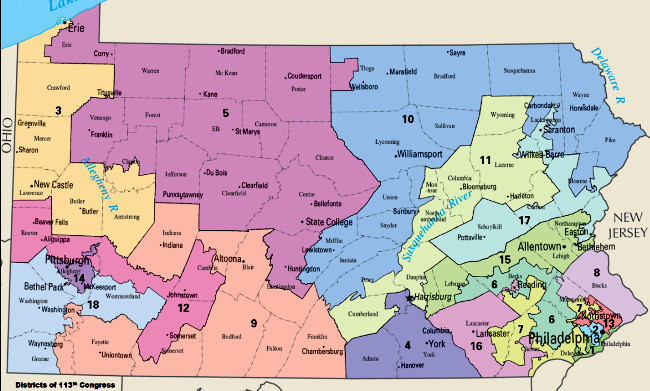
Last week, the Pennsylvania State Supreme Court ruled that the state’s Congressional districts were unfairly gerrymandered — that is, drawn to give the state’s Republican party an advantage — under Pennsylvania’s state constitution. This was a blow to the GOP, as Pennsylvania is widely seen as one of the most heavily gerrymandered states in the country. The ruling made two things clear: That the map would not be allowed in any further federal elections, including the upcoming May primaries, and that if the state legislature didn’t do it, they would. Now the state legislature has said it’s not going to do it.
Letters sent on behalf of the state senate essentially boil down to an argument that Article 1, Section 4 of the U.S. Constitution says they can do whatever they want. The exact text of that law is this:
The Times, Places and Manner of holding Elections for Senators and Representatives, shall be prescribed in each State by the Legislature thereof; but the Congress may at any time by Law make or alter such Regulations, except as to the Places of chusing Senators.
It also says that the court doesn’t offer a detailed discussion of just how these districts violate the state constitution, which, well, here’s the relevant text from the Pennsylvania state constitution, Article II, Section 16:
The Commonwealth shall be divided into fifty senatorial and two hundred three representative districts, which shall be composed of compact and contiguous territory as nearly equal in population as practicable. Each senatorial district shall elect one Senator, and each representative district one Representative. Unless absolutely necessary no county, city, incorporated town, borough, township or ward shall be divided in forming either a senatorial or representative district.
And here’s a map of Pennsylvania’s Congressional districts:

The numbers say it all. In 2016, Republicans got 53% of the vote, and Democrats 45% in Congressional elections. So, if the districts were reasonably fair, you’d expect between 8-10 Republicans and 8-10 Democrats depending on how a few races shook out. And yet, out of the 18 members of Congress Pennsylvania sent to Washington, 13 of them, or 72%, were Republicans. Keep in mind, a gerrymandered district isn’t designed to force your opponent out completely. It’s designed to limit the number of seats your opponent can win. And in four out of five of those Democratic wins, they were landslides.
The really thorny problem here is twofold. First of all, the State Senate does have a fair point: They haven’t been told why the map is unconstitutional, and they’ve got two weeks to draw up an entirely new map. The court needs to give them guidance, and detailed guidance.
Secondly, the Supreme Court could step in, but that raises a question of whether the federal government should tell the states what to do about laws within their own borders. It’s a messy chicken-and-egg question: Does the state constitution dictate the rules for the state legislature? Or does the Constitution overrule state constitutions on federal matters? Of course, this may all be moot: The Supreme Court has all but told us that they’ve got their own decision about gerrymandering on the way, and, well, let’s just say the signs aren’t good for the Pennsylvania Senate’s side of the argument.
(Via the Brennan Center For Justice)
